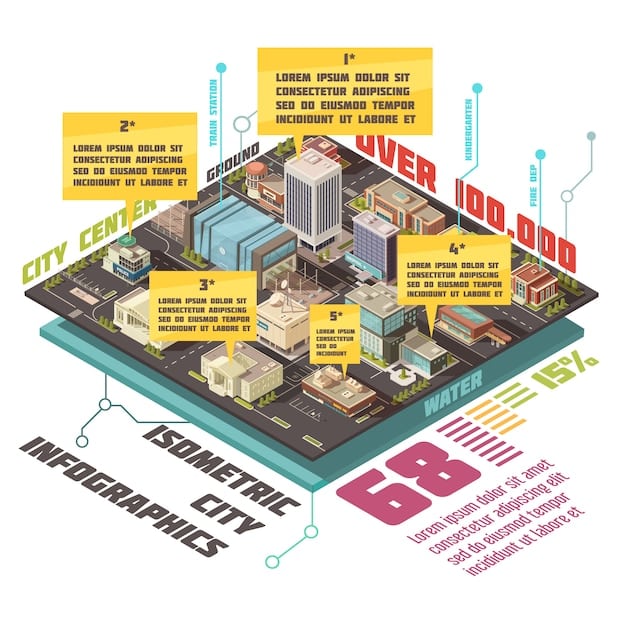US Smart City Initiatives: Developments & Investment

Smart city initiatives across the US are rapidly evolving, integrating advanced technologies like IoT and AI to enhance urban living, creating significant investment opportunities in infrastructure, technology, and public-private partnerships.
The concept of the “smart city” is no longer a futuristic dream but a tangible reality rapidly taking shape across the United States. From enhanced public safety to optimized traffic flow and sustainable energy solutions, US Smart City Initiatives: Latest Developments and Investment Opportunities are reshaping urban landscapes, promising a more efficient, resilient, and livable future for residents. But what exactly defines these urban transformations, and where do the most promising avenues for growth and investment lie?
Understanding the Smart City Paradigm
The essence of a smart city lies in its ability to leverage technology and data to improve the quality of life for its inhabitants, optimize urban operations, and foster sustainable growth. This isn’t about simply adding more gadgets to a city; it’s about creating an interconnected ecosystem where information flows seamlessly, enabling proactive decision-making and efficient resource allocation.
At its core, a smart city integrates various technological components, from the Internet of Things (IoT) sensors embedded in infrastructure to sophisticated data analytics platforms and advanced communication networks. These technologies collectively form the backbone of an urban environment designed for efficiency, resilience, and responsiveness. Municipalities are increasingly recognizing the multifaceted benefits, leading to a surge in projects aimed at transforming traditional urban centers into dynamic, intelligent hubs. The goal is to move beyond mere connectivity to achieve genuine intelligence that can adapt and evolve with urban needs.
Defining Characteristics of Smart Cities
Although no two smart cities are identical, certain fundamental characteristics unite these initiatives. They typically encompass a blend of technological integration, data-driven governance, and a strong emphasis on sustainability and citizen engagement. This holistic approach ensures that technological advancements serve broader community goals.
- Technological Integration: Pervasive use of IoT devices, AI, big data analytics, and high-speed communication networks (5G).
- Data-Driven Decision Making: Real-time collection and analysis of urban data to inform policy, resource allocation, and operational adjustments.
- Sustainable Solutions: Focus on energy efficiency, waste reduction, clean transportation, and green infrastructure.
- Enhanced Urban Services: Improvement of public services such as transportation, public safety, healthcare, and utilities.
Ultimately, a smart city strives for a symbiosis between human activity and technological capabilities, creating an environment where urban challenges can be addressed more effectively and opportunities for innovation can flourish. This paradigm shift requires not only technological prowess but also a forward-thinking governance framework and active community participation.
Key Technological Pillars Driving Smart City Evolution
The advancement of smart cities is intrinsically linked to breakthroughs in several key technological domains. These pillars provide the foundational infrastructure and analytical capabilities necessary to transform urban operations and enhance citizen experiences. Without robust technological underpinnings, the vision of a truly smart city remains largely theoretical.
The rapid evolution of connectivity, processing power, and data management has provided cities with unprecedented tools to address complex urban challenges. From managing traffic congestion to optimizing energy consumption, these technologies offer solutions that were once unimaginable. Understanding these pillars is crucial to grasping the full scope of smart city development.
The Internet of Things (IoT) and Sensor Networks
IoT devices are the sensory organs of a smart city. Thousands, if not millions, of interconnected sensors collect vast amounts of data on everything from air quality and traffic patterns to public space utilization and waste levels. This data forms the raw material for informed decision-making.
These networks enable real-time monitoring and control, allowing city officials to respond dynamically to changing conditions. For instance, smart traffic lights can adapt to traffic flow, and smart waste bins can signal when they need emptying, optimizing collection routes. The pervasive nature of IoT is what allows for the granular understanding of urban dynamics.
Artificial Intelligence (AI) and Big Data Analytics
Raw data is only as valuable as the insights derived from it. This is where AI and big data analytics come into play. AI algorithms process the enormous datasets generated by IoT networks, identifying patterns, predicting outcomes, and even automating responses.
- Predictive Analytics: Forecasting traffic congestion, crime hotspots, or utility demands to enable proactive interventions.
- Automated Operations: AI-powered systems managing energy grids, optimizing public transport schedules, or enhancing surveillance systems.
- Personalized Services: Delivering tailored information and services to citizens based on their needs and location.
The ability of AI to learn and adapt provides cities with an increasingly sophisticated capacity to manage complexity and deliver more efficient services. It moves cities beyond reactive measures to a more anticipatory and intelligent form of governance.
5G Connectivity and Advanced Communication Networks
High-speed, low-latency connectivity, particularly 5G, is indispensable for smart cities. It enables the real-time transmission of massive data volumes required for effective IoT operation and AI processing. Without robust networks, data bottlenecks would severely hinder smart city capabilities.
5G goes beyond just speed; its capacity for connecting numerous devices simultaneously and its minimal delay are critical for applications like autonomous vehicles, remote healthcare, and instant public safety communications. This next-generation connectivity acts as the nervous system of the smart city, ensuring all parts of the ecosystem can communicate effectively and instantly.
Key Sectors and Latest Developments in US Smart Cities
Smart city initiatives in the US are manifesting across a variety of urban sectors, each leveraging technology to address specific challenges and enhance service delivery. The developments are not uniform, with different cities prioritizing different transformations based on local needs and resources. However, common themes of efficiency, sustainability, and quality of life emerge across all sectors.
From infrastructure upgrades to improved civic engagement, the scope of smart city projects is vast and continually expanding. Understanding these sectoral developments provides insight into the practical applications of smart city technologies and their tangible impact on urban environments.
Smart Transportation and Mobility
One of the most visible impacts of smart city technology is in transportation. Cities are grappling with congestion, pollution, and the need for more equitable access to mobility options. Smart solutions aim to make urban travel smoother, safer, and more sustainable.
- Intelligent Traffic Systems: Real-time traffic monitoring, adaptive signal controls, and smart parking solutions to reduce congestion.
- Autonomous and Connected Vehicles: Pilot programs for self-driving shuttles and vehicles communicating with city infrastructure to improve safety and efficiency.
- Integrated Public Transit: Digital platforms for real-time bus and train tracking, smart fare collection, and demand-responsive transit services.
The goal is to create a seamless, multimodal transportation network that reduces travel times, lowers emissions, and enhances the overall urban experience. Developments in this sector are often at the forefront due to their immediate impact on daily commuter life.
Sustainable Energy and Resource Management
Energy consumption and resource management are critical areas for smart city development, driven by environmental concerns and the pursuit of operational efficiency. Smart grids, renewable energy integration, and intelligent water management systems are key components.
Cities are deploying smart meters to monitor energy and water usage with greater precision, enabling both utilities and consumers to identify inefficiencies. This data-driven approach supports conservation efforts and helps manage demand more effectively. Furthermore, the integration of distributed energy resources, like rooftop solar, into a smart grid allows for more resilient and decentralized power systems.
Projects often include smart street lighting, which not only saves energy through adaptive brightness but can also host additional sensors for environmental monitoring or public Wi-Fi. The emphasis here is on creating a resource-efficient urban ecosystem that minimizes environmental footprint and improves resource security.
Public Safety and Emergency Response
Leveraging technology for public safety is another significant aspect of smart city initiatives. Real-time data and interconnected systems allow for faster response times, more efficient resource deployment, and proactive crime prevention strategies.

Developments include smart surveillance systems with AI-driven analytics to identify unusual patterns, gunshot detection technology, and integrated emergency communication networks. These tools provide law enforcement and first responders with enhanced situational awareness and predictive capabilities.
Beyond traditional policing, smart city approaches to public safety extend to disaster preparedness and response, using sensor data to monitor environmental hazards or predict flood risks. The aim is to create safer urban environments through intelligent monitoring and rapid, coordinated responses to emergencies.
The application of these technologies requires careful consideration of privacy concerns and ethical guidelines to ensure that increased surveillance capabilities do not infringe on civil liberties. Balancing security needs with individual rights remains a critical challenge in this sector.
Navigating Investment Opportunities in Smart City Development
The burgeoning smart city movement in the US presents a fertile ground for investment across various sectors. As municipalities commit to these transformative projects, a diverse ecosystem of opportunities arises for technology providers, infrastructure developers, financial institutions, and specialized consultants. Understanding where these investments are flowing can inform strategic decisions for businesses and investors alike.
The sheer scale and complexity of smart city projects necessitate significant capital outlays, often involving public-private partnerships. This dynamic creates a demand for innovative financing models and collaborative ventures that can bring cutting-edge solutions to fruition. The market is not only for direct technology sales but also for services, maintenance, and long-term operational support.
High-Growth Segments for Investment
Certain segments within the smart city landscape are experiencing particularly rapid growth and attracting substantial investment due to their immediate impact and scalability. These areas are often where foundational technologies intersect with pressing urban needs.
- Smart Infrastructure: Investments in intelligent transportation systems, smart grids, and utility modernization are paramount. This includes sensors, control systems, and data analytics platforms for existing and new infrastructure.
- Data Platforms and Cybersecurity: As cities become more data-centric, robust data management platforms and sophisticated cybersecurity solutions are crucial. Investors are looking at companies specializing in secure data storage, analysis, and privacy protection.
- IoT Devices and Sensors: The demand for specialized IoT devices for various urban applications (environmental monitoring, asset tracking, public safety) continues to grow, offering opportunities for hardware manufacturers.
- Software and AI Solutions: Development of AI-powered applications for urban planning, predictive maintenance, public service optimization, and citizen engagement tools.
These segments represent the core technological components that underpin smart city functionalities, making them attractive for investors seeking exposure to the urban innovation market. The emphasis is on scalable solutions that can be replicated across different cities.
Public-Private Partnerships and Funding Models
Many smart city initiatives are realized through innovative public-private partnerships (PPPs). These collaborations allow cities to leverage private sector expertise, technology, and capital, while mitigating some of the financial risks. PPPs are becoming the preferred model for large-scale, complex projects.
Government funding, grants, and bond issues often provide foundational capital, but private sector investment rounds out the financing. Corporations, venture capital firms, and private equity funds are increasingly keen to participate in these mutually beneficial ventures. Models include service-level agreements, long-term concessions, and joint ventures where risks and rewards are shared.
Understanding the nuances of these funding models and the regulatory landscape for PPPs is essential for investors looking to engage with smart city projects. The long-term nature of these ventures often aligns with institutional investor strategies seeking stable, predictable returns.
Challenges and Considerations for Smart City Implementation
While the vision of intelligent urban centers is compelling, the path to full smart city implementation is fraught with challenges. These obstacles range from technological integration complexities to socio-political hurdles and ethical dilemmas. Addressing these considerations is crucial for the successful and sustainable development of smart cities.
Ignoring these challenges can lead to project failures, wasted resources, and even public distrust. A pragmatic approach involves acknowledging these hurdles upfront and developing comprehensive strategies to mitigate them, ensuring that the benefits of smart city technologies are broadly realized and sustained over time.
Data Privacy and Cybersecurity Concerns
The pervasive collection and analysis of urban data, essential for smart city operations, raise significant concerns about individual privacy and data security. The sheer volume and sensitivity of the data necessitate robust safeguards against breaches and misuse.
Cities must implement stringent data governance policies, comply with privacy regulations (like GDPR or emerging US state laws), and invest heavily in cybersecurity infrastructure. Public trust is paramount; without it, citizen adoption of smart services will falter. The balance between data utility and privacy protection is a constant tightrope walk for smart city planners.
Incidents of cyberattacks on municipal systems underscore the vulnerability of interconnected urban infrastructure. Protecting critical systems from malicious actors is not just about data integrity but also about ensuring the continuity of essential public services.
Interoperability and Standardization Issues
Smart city solutions often involve integrating disparate systems from multiple vendors, leading to significant interoperability challenges. Different platforms, data formats, and communication protocols can hinder seamless data flow and system integration.
The lack of universal standards can create vendor lock-in, limit scalability, and complicate future upgrades. Efforts are underway to develop common frameworks and open standards, but progress is slow. Cities must prioritize open architectures and interoperable solutions from the outset to avoid creating isolated technological silos.

Funding and Governance Models
Financing grand smart city visions requires substantial capital, and identifying sustainable funding models remains a challenge. While public-private partnerships offer a solution, navigating complexities like revenue sharing, risk allocation, and long-term maintenance agreements can be intricate.
Beyond funding, effective governance is essential. Smart city initiatives often cut across traditional departmental boundaries, requiring new collaborative structures and leadership. Coordinating diverse stakeholders—city departments, utility companies, private sector partners, and citizens—demands strong leadership and clear communication strategies to ensure alignment and progress.
The Future Outlook for US Smart City Initiatives
The trajectory for US smart city initiatives is one of continued growth and increasing sophistication. As technology evolves and cities gain more experience, the future promises even more integrated, intelligent, and responsive urban environments. The emphasis is shifting from simply deploying technology to achieving measurable outcomes that genuinely improve urban life.
The next decade will likely see greater convergence of different smart city domains, creating truly holistic systems rather than fragmented solutions. This convergence will foster new innovations and unlock further efficiencies, driving the evolution of urban living.
Emerging Trends and Technologies
Several emerging trends and technologies are poised to reshape the smart city landscape. These innovations will further enhance the capabilities of urban infrastructure and services, pushing the boundaries of what a smart city can achieve.
- Digital Twins: Creation of virtual replicas of cities that allow for real-time monitoring, simulation of scenarios, and predictive urban planning.
- Edge Computing: Processing data closer to the source (e.g., at the sensor level) to reduce latency and improve efficiency for time-sensitive applications.
- Blockchain for Urban Data: Potential use of blockchain for secure, transparent, and immutable records of urban transactions and data, enhancing trust and auditability.
- Advanced Robotics and Drones: Deployment of autonomous systems for public safety, infrastructure inspection, and delivery services.
These trends suggest a move towards increasingly autonomous and “self-aware” cities that can optimize operations with minimal human intervention, while also providing richer data for human decision-makers. The integration of these advanced technologies will be gradual but transformative.
Citizen Engagement and Inclusive Smart Cities
A crucial aspect of future smart city development will be a stronger focus on citizen engagement and inclusivity. A truly smart city is one that serves all its residents, bridging digital divides and ensuring that technology benefits everyone, not just a select few.
This involves co-creation initiatives where citizens actively participate in the design and implementation of smart city solutions, ensuring that deployed technologies address real community needs. Efforts to provide equitable access to digital infrastructure, skills training, and smart services will be vital to making smart cities truly representative and beneficial for diverse populations.
Future smart cities will be defined not just by their technological prowess but by their ability to foster vibrant, equitable, and sustainable communities where technology enhances human potential and well-being. The challenge lies in building intelligent systems that are also profoundly human-centered in their design and impact.
| Key Area | Brief Description |
|---|---|
| 💡 Tech Pillars | IoT, AI, Big Data, and 5G are foundational to smart city operations, enabling real-time data collection and analysis. |
| 🚗 Urban Mobility | Intelligent traffic systems, autonomous vehicles, and integrated public transit are optimizing urban travel. |
| 💰 Investment Outlook | High growth in smart infrastructure, data platforms, and AI solutions, often via public-private partnerships. |
| 🛡️ Challenges Ahead | Addressing data privacy, cybersecurity, and ensuring interoperability are key hurdles for successful implementation. |
Frequently Asked Questions
▼
The primary goal of US smart city initiatives is to enhance urban livability, efficiency, and sustainability by integrating advanced technologies. These initiatives aim to improve public services like transportation, safety, and energy management, ultimately creating more resilient and responsive urban environments that benefit all residents.
▼
Smart cities leverage IoT by deploying vast networks of interconnected sensors and devices across urban infrastructure. These devices collect real-time data on various parameters, such as traffic flow, air quality, waste levels, and energy consumption. This data is then used to optimize operations, inform decision-making, and automate responses to urban challenges.
▼
Investment opportunities in US smart city initiatives are diverse, spanning smart infrastructure (e.g., smart grids, intelligent transportation), data platforms, cybersecurity solutions, IoT device manufacturing, and AI-powered urban management software. Public-private partnerships are a common model, attracting capital from venture capitalists, private equity, and institutional investors.
▼
Major challenges for smart cities include ensuring data privacy and robust cybersecurity against growing threats, addressing interoperability issues between diverse technological systems, and establishing sustainable funding and effective governance models. Public acceptance and equitable access to smart city benefits also remain critical considerations for long-term success.
▼
5G connectivity is crucial for smart city development due to its high speed, low latency, and capacity for massive device connections. It enables real-time data transmission from IoT sensors, supports critical applications like autonomous vehicles, and facilitates instant communication for public safety. 5G acts as the vital nervous system, ensuring seamless integration and operation of smart urban systems.
Conclusion
The journey towards fully realized smart cities in the US is a complex but undeniably promising endeavor. By persistently integrating cutting-edge technologies, fostering innovative partnerships, and addressing critical challenges such as data privacy and interoperability, American cities are poised for a future marked by unparalleled efficiency, enhanced sustainability, and dramatically improved quality of life for their inhabitants. The ongoing innovations and evolving investment landscape signal a transformative era in urban development, cementing the smart city as a cornerstone of modern progress.





